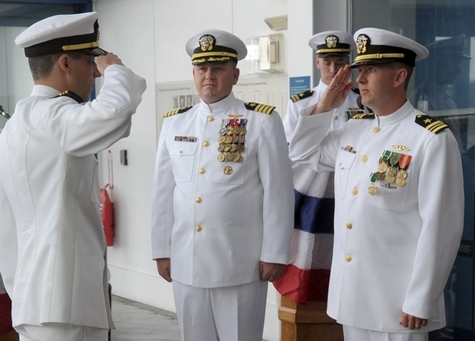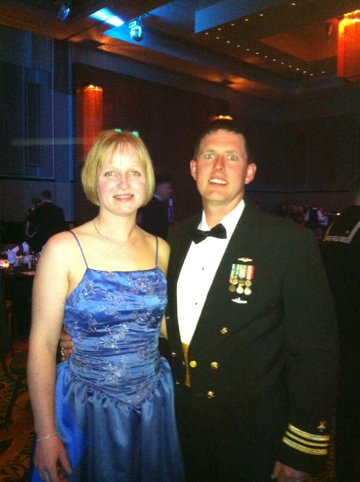Today, I was relieved as OIC of NAUTILUS and will now be moving on to a staff job at Naval War College in Newport, RI after a brief 30 days of leave. Below is a picture taken by The Day as seen in their article. I have also decided to include my speech.
Admiral Goebel, Captain Hendrix, and Captains, Casciano, Derenski, Verbeke, and Riegal, Members of the Submarine Force Library and Museum Association, Submarine veterans, family and friends, good afternoon and welcome.
First, to my beautiful wife Anna. Thank you for your love and support of my career and for everything you do to run our farm and raise our children, Alex, Vicki, and Amanda. To my parents, Ken and Liz; once again, you have rearranged your life to be present at a career milestone, just like all the other significant milestones in the past. I am grateful for your support throughout my life and I know the kids are happy you came.
Growing up, I was very active in the Boy Scouts, and my father was my Scoutmaster for many years. In Scouting, there are knots worn on the uniforms of leaders that signify awards or accomplishments. Some adults have many knots, while others have few. My father taught me the knots on your uniform have little value. The way you live your life, and the impact you have as a leader is more important than the awards you receive along the way.
While serving as Engineer on ANNAPOLIS, I met Capt Dennis McKelvey and his wife Susan who are joining us today. Capt McKelvey stands out as the most influential leader in my Navy career. There were a number of occasions when he chose decisions as CO that he personally felt was the right answer, regardless of external pressure to do something different. While it was not always the easiest choice, he stood by his decisions, a leadership trait I have tried to emulate.
Growing up, I remember visiting 3 significant naval locations that influenced my view of the Navy and contributed to why I chose the Navy over other military services. Those locations were, the battleship USS Alabama in Mobile, AL, The Naval Air Museum in Pensacola, FL (another NHHC Museum), and the aircraft carrier USS Yorktown in Charleston, SC. I have vivid memories of each of those locations, and every time I visited, I was intrigued to learn something new and take away a different appreciation for history and the Naval Force. I will admit, I never liked reading about history. In fact, I took the bare minimum number of history courses that I could while at the Naval Academy. However, I have always enjoyed experiencing history through walking civil war battlefields, visiting museums, and touring old Navy ships. For the past 2 years, I have had the opportunity to be a supporting part of that experience for the 300,000 visitors who came through this museum. The opportunity to impact the public perception of the Navy and tell the story of those who went before us, is hands down, what makes this job different from all my other experiences in the Navy.
The story of the submarine force is told by the people who volunteer as docents at the front desk, greeting visitors every day. It is told through the exhibits that we have and by the crew members interacting with visitors. I have been privileged to hear some of the more unique stories; many of which are not told in the halls of the museum, but might be in the future. I would like to share a few stories that stand out in my mind.
One nice day in 2012, a visitor came up to the offices and told us he had the original coffee maker that had been used on NAUTILUS and wanted to donate it. As the story was relayed, when NAUTILUS when into her first overhaul period, there was no space to store items removed as interference on jobs. The CO at the time decided to send these interference items home with Chiefs and Officers who lived in base housing for temporary storage in their garages. This particular coffee maker was one such item that had been stored in this Chief’s garage. The problem was, after the overhaul, a new coffee maker was installed and the old one was obsolete. The Chief maintained custody of the coffee maker for over 50 years, moving it from garage to garage until finally bringing it to the Museum for donation. Now many of you are probably thinking of a tall coffee pot like you might see in a conference room. However, this particular unit was closer to the size of washing machine. We actually considered trying to find a way to install it in the museum, but we no longer have anyone qualified and proficient to operate it.
Shortly after relieving as OIC, the museum staff began working with Subase on the dedication of the new Submarine Learning Center headquarters, Cromwell Hall. For our part, we conducted liaison with the Cromwell family, which eventually resulted in their decision to donate Capt John Cromwell’s Medal of Honor. In fact, I have been able to see 2 original Medal of Honors that we have in the collection here at the museum. When you consider the number of submariners that have served, while only 8 have received the Medal of Honor, it causes me great reflection on the significance of what those 8 did to earn our nation’s highest award.
Last summer, a young man, probably in his late 20s, came to the museum with a piece of fabric that was his grandfathers and had been handed down in the family. He currently had custody of it, and wanted to bring it by to share. On Nov 19, 1943, USS SCULPIN, (SS-191) was discovered by the Japanese destroyer YAMAGUMO. After attempting to evade depth charges submerged, the SCULPIN was forced to surface and man the deck guns. The destroyer’s deck guns were overwhelming, resulting in the death of the CO, Commander Fred Connaway. The ship’s senior surviving officer ordered SCULPIN scuttled. Crew members abandoned ship and were imprisoned at the ASHWIO POW camp. On Aug 19, 1945, the members of the POW camp all signed a piece of parachute that had dropped supplies to the camp. The names included Ed Ricketts, grandfather to the young man who brought in the piece of parachute. Another name on the piece is Clifford Kuykendall, who was the sole survivor from USS TULLIBEE (SS-284). However, one name that was NOT on the parachute, was Capt John Cromwell. You see, Capt Cromwell had been embarked on SCULPIN to lead a Wolfpack of submarines. Due to his significant knowledge of allied plans, he chose to go down with SCULPIN, vice being captured. For that, he was awarded the Medal of Honor which is now a part of our collection.
None of these stories would be saved, and I certainly wouldn’t know what I do about them if it wasn’t for the work of the Museum staff. I would like the following people to stand. Linda Williams, Wendy Gulley, Liz Murphy, Thaddeus Wakefield, Martha Barber, and the museum curator, Steve Finnigan. (APPLAUSE) Thank you for your work.
This museum would not be what it is without the contribution of a large list of both individuals and organizations. Thank you to the Submarine Force Library and Museum Association which is a vital part of this place supporting in particular, the development and maintenance of exhibits and education programs. Thank you to the crew who are the Navy’s PR representatives every day. Thank you to Regional Support Group, Electric Boat, NRMD, Public Works, and all the other behind the scenes organizations that keep this place running.
I am honored to have had the opportunity to preserve and improve the legacy of the Submarine Force for future generations, and I wish the best of luck to Ben as he leads the crew and staff as they continue this important mission and also to Capt Hendrix as he leads the Navy History and Heritage Command. I look forward to seeing how this museum grows in the future when I come back with my own kids as they continue to grow; to educate and inspire them, and ensure they appreciate the freedom provided by our military.


